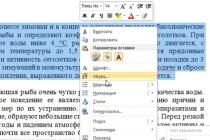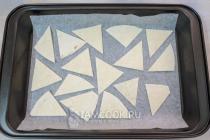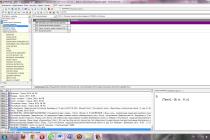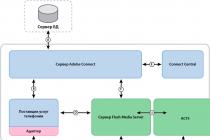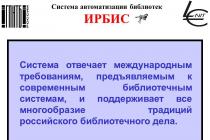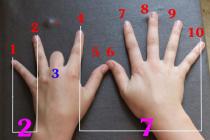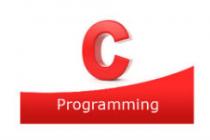It does not often happen that Russia becomes a launching pad for the launch of any new product, especially in the mobile computer market. Of course, we are talking about devices from world-class companies such as Samsung, products of Chinese manufacturers with modified Russian companies there are plenty of names on the market every day. One of these devices is the communicator - a newcomer to the large family of mobile computers under the general name Samsung Galaxy.
The great "fertility" of mobile device manufacturers, including Samsung, has both positive and negative sides. The positive aspects include meeting the needs of the maximum number of users by offering numerous models of communicators with different price-quality ratios. Simply put, the buyer always has the opportunity to choose a device according to his wallet, overpay for something, or save on something. In addition, the desire of mobile device manufacturers to seize leadership in all market segments results in serious competition and positively affects the price.
There are also plenty of negative aspects in the variety of models. Firstly, an unprepared buyer is simply lost among the multitude of offered devices, and a more knowledgeable fan of gadgets cannot always immediately answer how one communicator differs from another. WITH Galaxy devices S just turned out to be such a leapfrog. Now, for example, you can buy such models of communicators: the original Samsung Galaxy S, and, finally, the Samsung Galaxy S II. Also on the market there are numerous "simplified" and modified in various ways hybrids. All in all, according to the Yandex.Market service, there are 25 models of Samsung communicators running Android OS on sale. And now the Samsung Galaxy S Advance has joined them. Secondly, the abundance of new products leads to brevity life cycle communicators. For example, the production of the Samsung Galaxy S has ceased, although it has only been a few years since the smartphone was introduced to the market, which results, among other things, in a lack of spare parts and difficulties with repairs.
What is the difference between the new items and their predecessors, and why did Samsung need to release another Samsung Galaxy S communicator? To answer the first question, you need to look at the characteristics of the review hero, while the second question can only be answered by the developers of a mobile computer. However, we will try to give an answer to it.
Scope of delivery and characteristics
The communicator came to the editorial office with only a Micro-USB-USB cable.
The characteristics of the communicator Samsung Galaxy S Advance (I9070) are as follows:
 |  |
- STE U8500 processor (dual-core ARM cortex A9, frequency 1 GHz) with Mali-400 MP video core;
- Operating system Android 2.3.6 (Gingerbread);
- Super AMOLED display (PenTile), diagonal 4 inches, 480 × 800 pixels (WVGA), capacitive, with multitouch;
- 768 MB RAM, 2 GB main flash (1.75 GB available), 7 GB optional flash;
- Communication GSM 850/900/1800/1900 MHz, GPRS / EDGE;
- Communication 3G UMTS 850/900/1900/2100 MHz, HSDPA 14.4 Mbps; HSUPA 5.76 Mbps;
- Bluetooth v3.0 + HS;
- Wi-Fi 802.11b / g / n, Wi-Fi hotspot;
- GPS, AGPS;
- Slot for microSDHC cards;
- FM radio, RDS;
- Position sensor in space;
- Light sensor;
- Magnetometer;
- Camera with 5 megapixels, autofocus and flash, 720p video recording;
- Lithium-ion battery with a capacity of 1500 mAh;
- Dimensions 123 x 63 x 10 mm;
- Weight 122 g.
Judging by the capabilities and parameters of the hardware filling, the hero of the review turned out to be a hybrid of the first and second generation Galaxy S communicators, occupying an intermediate position between them (which is hinted at by the model index). The case and display are related to the pioneer of the Galaxy line of the hero of the review, with the Galaxy S II the novelty is similar to a dual-core processor, graphics accelerator and software filling.
Design and appearance
The appearance of the novice communicator is fully consistent with the style of Samsung - almost everything Galaxy smartphones S look alike like twins. A thin plastic case in a candybar form factor, a rough rear panel (by the way, more practical than a glossy one in Galaxy S Plus), a rectangular central key, the same set of controls and their location ... The difference between communicators is only in details and dimensions. It seems that Samsung has made its choice in terms of the design of the main models of communicators and does not plan to abandon it, another confirmation of this is.
The dimensions and weight of the new items are almost the same as those of the Galaxy S and Galaxy S Pro. All the difference is imperceptible and invisible fractions of a millimeter and grams. The Samsung Galaxy S Advance is slightly thicker than the Galaxy S II, but narrower and shorter. All of these communicators fit well in the hand, fit in a pocket and do not distract the eye with design delights from contemplating a picture on an AMOLED display.
The Galaxy S Advance lacks sharp corners and edges. Case material - plastic of two types: matte black and metallic gray. The latter remarkably collects fingerprints, as well as the protective glass on the front panel. There are no complaints about the assembly of the communicator, all parts fit perfectly, there are no creaks or backlashes.

The front panel of the novelty is what makes the Galaxy S Advance somewhat unique communicator in the family (if not to take into account). It's about concavity protective glass and, accordingly, the roundness of the mobile computer case. The effect is noticeable when you look at the communicator in profile, and when the device just lies in your hand, there is not much difference with the flat predecessors. Any tangible additional convenience from moving the finger along a curve from point A of the display to point B is also not observed.
The communicator's case is thicker in its lower part - where the button for returning to the main screen of the system and two touch keys are located. The latter are highlighted from the inside. The upper part of the front panel houses the communicator's telephone speaker, an additional camera, and ambient light and proximity sensors.

The rear panel of the communicator is a battery compartment cover. It can be easily detached and reinstalled. The part is made of flexible plastic, but it's better not to check its strength once again. The cover provides holes for the camera lens, flash and speaker of the device. The memory card and SIM card can be accessed without disconnecting the battery.

The volume control key is located on the left side of the mobile computer case. On the right is the communicator power control button.
The upper end of the communicator case is clean, and the lower one is used to accommodate the Micro-USB and 3.5 mm headset connectors. Next to them is the main microphone of the device.

The exterior of the communicator did not evoke any particular emotions, except for a slight sense of déjà vu. All design elements are verified, the colors are standard, the feeling from using the computer is positive. One thing remains unclear - how do you differentiate the many Galaxy S clones and enhancements from each other on the store shelf?
Software and settings
As a shell over the operating system Android 2.3.6, the communicator has a well-known Samsung program TouchWiz 4.0... The exact same shell is used in the Samsung Galaxy S II. It makes no sense to dwell in detail on the features of this version of TouchWiz - after all, firstly, along with the Galaxy S III, its new version appeared, and secondly, its functionality and interesting points were described in the review Samsung flagship 2011 year.
After unlocking, the user of the Samsung Galaxy S Advance communicator goes to the main screen of the system. The arrangement of widgets and icons on seven tabs of the screen is standard for the company's communicators. On the first there is a clock, a weather forecast widget AccuWeather, google search engine, icons Samsung Social Hub, Samsung Apps, Google play and google maps... The next tab contains the email client widget, the third: gallery widget, browser favorites, stock quotes widget, icons Samsung Game Hub, Gmail and Google talk.
 |  |
Various hubs (Hub) - Samsung's attempt to collect the functionality most demanded by the communicator user within several proprietary applications. Social Portal(Social Hub) includes mail client for many accounts, as well as clients of social networks such as Twitter, LinkedIn and Facebook... After setting up, SMS messages will also be poured into the general heap. Game hub- a collection of worthy, in the opinion of the developers of this program, installation on the communicator of games.
 |  |
Samsung engineers install a branded app store on all their smartphones Samsung Apps Galaxy S Advance is no exception. Samsung's services and programs also include: Kies air- an application for wireless synchronization of a mobile computer with a big brother, AllShare- a program for gaining access to media resources on the network and providing it to the contents of the communicator to other devices using DLNA technology.
 |  |
In addition to Google services mentioned earlier and the set standard applications, in the Samsung Galaxy S Advance there was a place for third-party programs, for example, Polaris Office- an application for working with files in the popular Microsoft Office format. Unlike many smartphone manufacturers who install a version of the program with limited functionality (view only documents), the developers of the Galaxy S Advance did not stint and provided a version with a full set of features.
 |  |
Next on the list are several gaming applications: MOGames, Texas HoldEmPocker and The sims 3... Unfortunately, only the first game is workable of them - a set of chess, checkers and reverse, which can be played both with a computer and with a live opponent over the network.
 |  |
Talking about third-party applications in Samsung Galaxy Advance, one cannot fail to mention the replacement of the original keyboard - a well-known application Swype... Someone may find it convenient to use your finger on the keyboard, while others may not find it very convenient, because of big size finger, but the availability of an alternative to the standard virtual keys in the form of a free program is always welcome.
 |  |
Display and sound
The type, resolution and size of the matrix in the Samsung Galaxy S Advance are exactly the same as in the famous predecessor - Samsung Galaxy S. A similar matrix is installed in the Samsung Galaxy S Plus. The resolution of the four-inch Super AMOLED display is 800 × 480 pixels. The physical dimensions of the matrix: 86 × 52 mm - thus, the dot density is approximately 222 dpi.
In the manufacture of the matrix, PenTile technology was used - the matrix cells responsible for displaying one of the three basic colors are arranged in a special way, with a predominance of green subpixels. Outwardly, this is expressed in the form of a special "graininess" of the image on the screen, blurring of small text, it also seems that a certain grating is imposed on the display. However, this feature of the display is not noticeable to many, and when compared with the Galaxy S II, the matrix of which is arranged in a more familiar way with the same subpixel size, they do not see the difference in the picture of the two communicators.
As with any AMOLED display, the picture on Samsung screen The Galaxy S Advance features rich, vibrant colors, high contrast, and a particularly deep black. The high brightness of the display allows you to successfully deal with external light, the communicator can be used on a sunny day, but the glossy surface of the screen in the form of a protective glass makes significant adjustments to the picture quality. In addition to protecting the matrix, Gorilla Glass perfectly collects fingerprints, reflects the face of the communicator's owner and other objects in bright ambient light.
The capacitive sensor of the display supports multiple touches, 10 simultaneous signals have been tested - there were not enough fingers for more.
The tilt of the communicator in any direction has practically no effect on the color rendering of the picture on the screen. The lack of significant color distortion when changing the viewing angle is one of the advantages of OLED technology.
Volume control of two communicator loudspeakers is carried out both by software and by means of a key on the left side of the mobile computer case. The built-in music player allows you to enable 5.1 multi-channel sound emulation, adjust the equalizer, or select one of the prepared sound enhancement effects.
The volume of all communicator loudspeakers is good and sufficient. The main one successfully copes with playing ringtones, alarms and navigator prompts. The telephone speaker, together with the microphone, provides high quality negotiations with the interlocutor.
Samsung Galaxy S Advance's built-in FM radio only works when headphones are connected. Station signals are recognized confidently, RDS technology is supported. Tuning the receiver does not take long: the user-friendly control program automatically searches for stations. The frequency can also be specified manually, though not in the most convenient way - by scrolling the virtual tuning wheel of the receiver and then saving it in the communicator's memory.
 |  |
Camera
As befits a modern communicator, the review hero is equipped with two cameras: the main one on the rear panel and the additional one in front. The resolution of their light sensors is 5 megapixels and 1.3 megapixels, respectively. Thus, the maximum image resolution of the Samsung Galaxy S Advance is 2560 × 1920 pixels. Video is shot in MPEG-4 / H.264 format with 720p resolution and 30 frames per second.
The main camera is equipped with an autofocus system and LED flash. However, the lack of a separate shooting control key is only regrettable. There is no separate shortcut key for opening the camera control application on the unlock screen in the Samsung TouchWiz shell, as is done in many modern communicators. In general, the program has to be launched the old fashioned way with a few extra finger movements.
 |
It takes some time for the camera to turn on, but the autofocus system is activated and the picture is taken very quickly. For the camera built into the communicator, the quality of the photos and videos received is acceptable. There is only one limitation on the number of the first and the duration of the second - the amount of free memory.



Wireless interfaces and communication
There were no problems with the communicator's operation in various communication networks. Samsung Galaxy S Advance has a full range of wireless modules, all modern data exchange standards are supported (except for 4G networks).
Module management cellular communication 2G / 3G, Wi-Fi 801.11a / b / g / n module and Bluetooth 3.0 + HS realizes operating system... The communicator successfully connects to existing networks as a client and becomes an access point itself. Many Bluetooth profiles are supported, including A2DP.
The communicator can wirelessly sync with a desktop computer using the Kies Air software. Access to the multimedia contents of the smartphone memory is possible through DLNA or AllShare technology. With its help, the owner of the smartphone gains access to the resources of other computers on the network.
 |  |
Unfortunately, unlike the Samsung Galaxy S II, the new product does not have support for TV-out and USB-host technologies. At least there is no information about this on the official page of the device description on the Samsung website.
Battery life
The capacity of the standard lithium-ion battery of the Samsung Galaxy S Advance is 1500 mAh. By itself, this value is higher than the average for the fleet of mobile devices, but the true state of affairs with the autonomous operation of the communicator can only be shown by a series of tests.
The hero of the review was subjected to several tests and here are their results: playing music with the display off lasted 36 hours, reading a book in FB Reader with a screen brightness of 50% - 10 hours, the same thing, but with automatic brightness control - 12 hours, navigation using Yandex.Maps - 5 hours. The minimum operating time from a single battery charge is 4 hours. The communicator's results are good, but nothing more.
In normal use, the newcomer showed himself better, having worked for a day and a half. During testing, the communicator was used as a phone, a wireless access point, they went online and sent messages from it. The result may not seem outstanding, but everything is learned by comparison. For example, a Samsung Galaxy S II after a firmware update to ICS 4.0 remains operational for at best 12 hours under the same operating conditions.
Communicator Samsung Galaxy S Advance is able to provide adequate battery life, if you make allowances for the "gluttony" common for modern mobile devices in certain operating modes. In conclusion, it should only be noted that recharging the battery takes 4 hours.
Performance
The hardware platform of the Samsung Galaxy S Advance is somewhat unusual. By its basic parameters, it looks commonplace for 2012, judge for yourself: a dual-core ARM Cortex v9 processor with a frequency of 1 GHz and 768 MB random access memory... The choice of SoC is unusual for Samsung's device - namely, the product of the Swedish-French-Italian conglomerate ST-Ericsson NovaThor U8500. As you know, Samsung independently develops and manufactures a variety of electronic products, including processors for smartphones. Considering that the Mali-400 chip is used as the graphics core, the key component of the Samsung Galaxy S Advance filling almost matches the processor. Samsung Exynos 4210, used, for example, in the Samsung Galaxy S II. The main difference between the two chips is the frequency, the Exynos is 20% faster.
 |
Comparison with communicators that have been tested earlier should show how justified Samsung's decision was to use this chip.
| Samsung Galaxy Advance 2 × 1 GHz (Android 2.3) | Huawei Honor 1.4 GHz (Android 4.0) | LG Optimus Sol 1 GHz (Android 2.3) | Samsung Galaxy S 2 × 1.2 GHz (Android 2.3) | HTC Sensation 2 × 1.2 GHz (Android 2.3) | Samsung Galaxy S 1 GHz (Android 2.3) | Samsung Galaxy S 1 GHz (Android 2.1) | |
| Graphics | |||||||
| Total graphics score | 26.031881 | 74.65942 | 57.328293 | 34.054173 | 63.32414 | 30.028656 | 30.482296 |
| Draw opacity bitmap (MPixels / sec) | 9.300636 | 26.701435 | 19.56065 | 11.17294 | 22.188517 | 8.854302 | 9.3687105 |
| Draw transparent bitmap (MPixels / sec) | 6.621403 | 18.962963 | 15.503407 | 9.655823 | 16.542812 | 9.512309 | 9.275363 |
| CPU Whetstone | |||||||
| Total CPU score | 3108.2927 | 3200.6553 | 1999.432 | 3261.4143 | 2500.6213 | 1571.6143 | 771.9937 |
| MWIPS DP | 205.33882 | 195.69472 | 128.3697 | 181.4882 | 162.86644 | 97.84736 | 57.636887 |
| MWIPS SP | 230.94688 | 257.73196 | 167.78523 | 296.7359 | 190.4762 | 108.813934 | 60.79027 |
| MFLOPS DP | 40.426186 | 17.900549 | 8.925826 | 12.005697 | 26.03444 | 6.510691 | 7.3144784 |
| MFLOPS SP | 48.453373 | 46.086174 | 16.762455 | 34.02756 | 34.39461 | 14.372471 | 8.3832655 |
| VAX MIPS DP | 170.15817 | 190.61703 | 114.365166 | 156.00337 | 143.94771 | 111.43894 | 39.92782 |
| VAX MIPS SP | 168.32018 | 181.2764 | 119.336716 | 225.92809 | 137.0819 | 97.69196 | 40.446907 |
| Memory | |||||||
| Total memory score | 389.28192 | 550.8008 | 482.2524 | 782.7169 | 792.86743 | 647.3529 | 600.7096 |
| Copy memory (Mb / sec) | 353.73187 | 500.5005 | 438.2121 | 711.23755 | 720.4611 | 588.2353 | 545.8515 |
| Filesystem | |||||||
| Total file system score | 211.17836 | 279.8356 | 101.20107 | 325.3547 | 213.823 | 74.25825 | 143.54076 |
| Creating 1000 empty files (sec) | 0.285 | 0.338 | 0.547 | 0.256 | 1.342 | 13.402 | 41.504 |
| Deleting 1000 empty files (sec) | 0.167 | 0.129 | 4.009 | 0.13 | 0.408 | 25.047 | 27.346 |
| Write 1M into file (M / sec) | 112.35955 | 128.20512 | 149.25374 | 99.0099 | 13.513514 | 37.037037 | 3.068426 |
| Read 1M from file (M / sec) | 312.5 | 434.78262 | 54.347828 | 555.55554 | 416.66666 | 112.35955 | 285.7143 |
| SD card perfomance | |||||||
| Creating 250 empty files (sec) | 3.3 | 4.556 | 19.808 | 9.34 | 8.588 | 3.444 | 11.908 |
| Deleting 250 empty files (sec) | 4.82 | 5.076 | 52.244 | 12.42 | 4.772 | 3.0 | 13.684 |
| Write 1M into file (M / sec) | 54.347828 | 57.471264 | 14.556041 | 23.364487 | 26.88172 | 16.10306 | 20.833334 |
| Read 1M from file (M / sec) | 322.58066 | 400.0 | 312.5 | 312.5 | 357.14285 | 344.82758 | 303.0303 |
So, the calculations turned out to be the “hobbyhorse” of ST-Ericsson NovaThor U8500. This chip received a high average score in processor performance tests. The newcomer performed especially well in the floating point operations discipline, outperforming not only its predecessor, but also the flagships of last year.
The Samsung Galaxy S Advance showed itself less successfully in 2D graphics tests, losing out to almost all communicators presented in the table. Exactly the same can be said about memory tests. Judging by the results in Benchmark, the filling of the hero of the review is very peculiar in terms of performance, Samsung Galaxy S Advance managed to take both the first and last places in the tests.
In the Quadrant Standard test, the newcomer to the smartphone market performed well, earning 2,555 points. For comparison, the result of the Samsung Galaxy S II is 3125 points.
In another popular benchmark - AnTuTu, the hero of the review received 4726 points. Both tests showed that the Samsung Galaxy S Advance is a "solid middling".
There are a lot of tests for the Android platform, and all are free, so nothing prevented them from running them on the Samsung Galaxy S Advance and demonstrating the results in this review.
Multiple calculations of the precision of the number "pi".
A benchmark in 3D rendering.
Video playback is quite within the power of a beginner, unless it is a 1080p video (MP4, 7 Mbps, AVC / AAC). The stock player could not open it, and MX Video Player played back with noticeable delays. The communicator coped much better with 720p video (MP4, 4.5 Mbps, AVC / AAC). Video in the more popular format and resolution (AVI, 720x400 pixels, 1.2 Mbit / s, XVID / MP3) was reproduced, including with a regular player, without the slightest problems.
conclusions
At the very beginning of the review, two questions were raised, the first of them is answered by the text of the previous sections of the article, we will try to answer the second here. It is obvious that the extensive development of communicators continues, processors are increasing the number of cores, displays are increasing resolution, and the amount of built-in memory is growing. The current 2012 should be the year of mobile processors with four cores, the year of displays with HD-resolution and the year when the volume of the built-in memory of the communicator should cross the 64 GB line. Coming soon new flagship Samsung line- Galaxy S III; accordingly, the entire look of the product line must change. Dual-core processors and WVGA-screens, thus, become the lot of communicators of the middle price range, it is in it that the Samsung Galaxy S Advance should firmly take hold.
However, several circumstances can prevent a beginner from doing this. First of all, this is the price of the novelty. The average price range ranges from 10 to 20 thousand rubles, and it is very important, closer to which border the cost of the communicator is. After all, it will depend on which competitors in the market the novelty will face. And it is the high competition that is the second obstacle to the popularity of the novelty. It is one thing when a communicator is compared with a legion of different devices in the price zone of 10 thousand rubles, and quite another when a buyer makes a choice among models in the upper price range. Unfortunately, by the will of anonymous Samsung employees, Galaxy S Advance got into the price range of "about 20 thousand rubles", where it is lost among devices such as iPhone 4, Samsung Galaxy S II and many other "top" communicators.
The smartphone itself has absorbed many of its predecessors and turned out to be very successful. High-quality screen, good battery life and performance - these are the main advantages of the Samsung Galaxy S Advance - but only as a mid-range device; he cannot compete with the flagships of 2012. Popularity can be ensured to him, but only if the cost is more adequate.
Samsung Galaxy S Advance was announced in winter 2012, in January, and the smartphone went on sale only in April. The device is positioned as a budget version of the flagship of 2011 - a smartphone. The device has a "simpler" screen, with a smaller diagonal and a Super Amoled matrix, nevertheless, the phone turned out to be very good and rightfully occupies a worthy place in its price category.
Appearance
Outwardly, Galaxy Advance looks very much like an I9100, a similar, elongated, rectangular shape with rounded corners. The front panel is glossy, while the back is made of soft-touch, ribbed plastic. The material is quite practical and resistant to any scratches. The dimensions of the smartphone are 123.2 x 63 x 9.7 mm, and the thickness is 120 grams.
Smartphone video review
Specifications
The device is based on the STE U8500 chip, has a dual-core processor with a frequency of 1 GHz and the popular Mali-400MP video accelerator. The built-in memory can be 8 or 16 GB, and 768 MB of RAM. The battery in the i9070 is not that capacious, at 1500 mAh. It cannot be said that this is a lot, since 2 cores and such a "video card" require a lot of energy.
Screen and camera
The screen is quite good here, its diagonal is 4 inches, and the resolution is 840 x 480 pixels, but the manufacturing technology here is PenTile. The pixel density is approximately 233 ppi. Nevertheless, the picture looks very good. The main camera does not shine with anything special, has autofocus and is capable of taking pictures with a resolution of 5 megapixels (2592 x 1944), as well as recording video at 720p.
Contents of delivery:
- Telephone
- Battery
- Charger
- Stereo headset
- USB cable
Positioning
South Korean company Samsung has released the Galaxy S Advance - another smartphone operating room Android systems... The first model of the "Galaxy" line - i9000 was taken as a basis. A new dual-core processor was “screwed on” to it, some memory was added and the case was reshaped. The camera, diagonal and screen resolution, as well as the type of matrix remained the same. It will be interesting primarily for those who need a fast and convenient phone with an optimal 4-inch diagonal for comfortable work.
The press release said the device will go on sale at the end of February. However, at the time of writing this review (end of March), the Samsung i9070 is only available for pre-order. The cost is rather big - about 20,000 rubles, however, it can be assumed that closer to summer, if not earlier, it will fall to 15,000 - 16,000 rubles.
Design, dimensions, controls
About appearance Advance will say just a few words, since it practically does not differ from previous models. The only detail is the slightly curved body, which, again, we saw in the "first" and "second" Nexus. It looks good, and is quite pleasant in terms of tactile sensations. It also fits well in the palm, thanks to the curved back and smoothed sides. Made from plastic. The prints only remain on the screen and can be wiped off relatively easily, for example with a microfiber cloth. The back cover has a small embossed pattern in the form of a grid, so it will hold confidently in the hand. The assembly is excellent: no creaks, no backlash, and the lid does not push through to the battery.
Galaxy Dimensions The Advance is 123.2 x 63 x 9.7mm and weighs 120 grams. It turns out that it is thinner and narrower than the Samsung i9000, but slightly higher.
On the front panel there are two sensors - proximity and lighting, next to the front camera and the earpiece. Its volume is average, I would like to have a margin. The interlocutor is heard clearly and legibly.

Under the screen: a rectangular button "Home" (relatively firmly pressed and when pressed, a characteristic "click" sound is heard) and two touch buttons - "Back", "Menu". Their illumination is white, very dim, not visible during the day.

In the settings on center button you can schedule the answer to the call.
On the left - a wide and thin volume rocker key, on the right - the on / off button of the device, it also acts as a screen lock. At the bottom there are: a microUSB port, a standard 3.5 mm audio output for headphones or a headset, a microphone (there is no second one for noise cancellation and stereo sound recording).






The camera module, flash and speaker are on the back of the device.
To remove the cover, you need to pull on the notch on the lower right edge. The memory card slot is on the top right (hot swap supported), the sim card is installed on the left.


Samsung Galaxy Advance (left) and Samsung Galaxy Note

Samsung Galaxy Advance (left) and Samsung Galaxy S (i9000)

Samsung Galaxy Advance (left) and Sony Ericsson Play
Display
This smartphone model uses a SuperAMOLED screen matrix. Unfortunately, the pixel building technology is the same as in the i9000 - PenTile. This means that if you look closely at the text or icons, they will seem a little "loose" to you. Especially noticeable in a web browser. Personally, it doesn't bother me in any way.
The diagonal of the display did not increase (fortunately, it did not decrease) and amounted to 4 inches, the resolution is traditional for an average price segment Android devices - 480x800 pixels, density - 233 pixels per inch. The sensor is naturally capacitive and supports up to 10 simultaneous touches. The sensitivity is comparable to SGS II.
As for the color rendition, the Advance slightly leads to warm shades, while the Galaxy S “first” - to cold ones. Brightness (adjusted automatically or manually) and contrast are the same. The viewing angles are great, but when tilted, the picture takes on a slight greenish tint. In the sun, the screen does not fade much, the information remains readable, however, in this parameter it loses to the SGS II and Prada displays from LG.
The device has an accelerometer (BMA222), a magnetometer (YAS530), a gyroscope (MPU3050), a combined light and proximity sensor chip (GP2A).
 |
 |
 |
 |

In the "Screen" settings, the font is selected, the background screen saver and the position of the clock on the "Lock Screen" are changed. In the parameters there is a special function "Energy Saving": its essence lies in the fact that the device analyzes the image on the display, and if it is dominated by white color, the brightness decreases slightly. There are settings for turning off the backlight of the touch buttons.
Samsung Galaxy Note (bottom), Samsung Galaxy S i9000 (center) and Samsung Galaxy Advance displays:

Viewing angles Samsung Galaxy i9070
Battery
The Samsung Advance uses a 1500mAh Li-Ion battery. Model EB535151VU. The manufacturer does not indicate the operating time of this model. But if you use the phone for about 15-16 hours, then the battery will be completely discharged provided: 20-25 minutes of conversations a day, three hours of using Wi-Fi Internet (Twitter, mail, downloading applications and installing them), about five hours of mobile Internet while listening to music (a couple of hours). Great energy saving results!

More numbers:
- Only in talk mode, the device works up to 7 hours
- Only when playing video (720p) at maximum volume in headphones and maximum screen brightness - just over 10 hours
- Only playing music in headphones at maximum volume - about 30 hours.
 |
 |

Gains almost twice as many points as single-core counterparts and many dual-core ones.
It charges relatively quickly from USB - in an hour, from the network - in the same time.
In the settings there is a special section "Energy saving". You have the right to enable or disable this feature. There are many options: turn off Wi-Fi when there is no connection to mobile internet, turn off Bluetooth and / or GPS when idle, turn off sync, change backlight brightness, etc. There is even an item "Tips for Energy Saving".
Communication capabilities
The smartphone operates on 2G (850/900/1800/1900 MHz) and 3G (850/900/1900/2100 MHz) cellular networks. HSDPA speed - up to 14.4 Mbps, HSUPA - up to 5.76 Mbps. Available Bluetooth version 3.0 HS (with A2DP stereo profile).
 |
 |
 |
 |
There is a wireless Wi-Fi connection 802.11 a / b / g / n. The device can be used as an access point (Wi-Fi Hotspot), file transfer (Wi-Fi Direct) and multimedia content (DLNA). In the "settings" there is an item "Modem and access point". Samsung connects to a computer over the air using Kies via Wi-Fi. For the entire time of operation, the network did not "fall".
 |
 |
High-speed USB 2.0 is also used for file transfer and data synchronization. When connected to a PC, Advance is detected as a USB Flash device or USB tethering.
SAR value
Your phone has been manufactured to comply with the exposure limits for radio frequency (RF) energy as recommended by the Council of the European Union. These standards prohibit the sale mobile phones whose radiation level (called specific absorption rate, SAR) exceeds 2.0 watts per kilogram of body weight. During testing (information provided by Samsung), the maximum SAR recorded for this model was 0.543 watts per kilogram. In normal use, the SAR is much lower because the phone emits only the amount of RF energy needed to transmit a signal to the nearest base station. By automatically lowering the radiation from your phone, you can reduce your exposure to radio frequency energy.
Memory and memory card
Samsung Smartphone The i9070 has 768 MB (in reality - 555 MB, and about 300 MB of free on average) of RAM, sufficient for most tasks. 4 GB of Flash memory and 2 GB of system memory are allocated for installing applications, photos, music and videos. In a press release, it was said that there will be two versions of the device: with 8 GB and 16 GB. We must assume that we have Samsung review 8 GB, although 4 and 2 add up to only 6 GB. It doesn't matter: there is still a slot for a microSD memory card, the maximum volume of which can be up to 32 GB.
 |
 |
Camera
The Galaxy i9070 has two camera modules: 5-megapixel (with autofocus) and 1.3-megapixel (front, no autofocus, for video calls). There is a one-section LED flash.
The quality of the photos is no better, but also no worse than the shots taken with Samsung Ace, Omnia W and Wonder: natural color reproduction, a little color noise even in shots taken at night. From the EXIF information of the photo file, we managed to find out that the aperture number is f / 2.7, the minimum shutter speed is 1/1000, and the maximum one is 1/8.

Video filming is carried out in a resolution of 1280x720 (720p) without autofocus at 30 frames per second. Good quality.
There is no separate “photo” button in the device, so the camera is activated by clicking on the corresponding icon on the screen. The camera shoots quickly, there is no visible delay between pressing the screen and taking the frame. But in terms of speed it is still inferior to smartphones from Sony and Sony Ericsson.
Camera interface
On the left there is an icon for switching from the main camera to the front camera and vice versa, a flash (disable, enable forcibly and set to automatic), settings. On the right - the choice of the mode (camera or video camera), the button for activating the shutter and the entrance to the gallery.

Camera settings
- Self-portrait. Switch to front camera
- Flash. Enable or disable
- Shooting mode. The user can choose from one shot, a smile shot, a cartoon, a panorama and a shot in motion.
- Plot (no, portrait, landscape, night, sport, room, sunset, dawn, autumn colors, text, candle, backlight)
- Exposure value (-2 to +2 in 0.5 steps)
- Focus mode. Auto focus or take pictures in macro mode
- Timer (turn on / off)
- Resolution (from 640x480 to 2560x1920 pixels)
- ISO (auto, 100, 200 and 400)
- Exposure metering. These are options for adjusting the exposure in the center of the frame, spot and across the entire field of the frame.
- Auto contrast (enable / disable)
- Blink detection
- Net
- Image quality
- GPS. Ability to leave location data in EXIF information
- Resetting all camera settings




Camera interface
On the left there is an icon "Recording mode" (normal, restriction for MMS, recording from the front camera), flash (disable, enable forcibly and set to automatic), settings. On the right - the choice of the mode (camera or video camera), the button for activating the shutter and the entrance to the gallery.

Camcorder settings
It contains the following items:
- Backlight (enable or disable)
- Recording mode. Ability to record videos in the usual way, for MMS or video recording on the front camera
- Exposure value
- Timer
- Effects (none, negative, grayscale, sepia)
- Resolution (from 174x144 to 1280x720 pixels)
- White balance (auto detect, daylight, cloudy, incandescent)
- Video quality
- Net
- Memory (internal or card)
- Resetting all camcorder settings


A photo album looks normal for Android.
Video file characteristic:
- File format: MP4
- Video codec: AVC, 12 Mbps
- Resolution: 1280 x 720, 30 fps
- Audio codec: AAC, 63 Kbps
- Channels: 1 channel, 44 kHz
Sample photos:
 |
 |
 |
 |
 |
 |
 |
 |
 |
 |
 |
 |
 |
 |
 |
 |
 |
 |
 |
 |
 |
 |
 |
 |
 |
 |
 |
 |
 |
 |
Panoramic photos:
Performance
Samsung has equipped Galaxy model S Advance dual core ARM processor Cortex-A9 with clock frequency 1 GHz (average - 800 MHz, minimum - 200 MHz) of each of the cores. The device operates on the NovaThor U8500 chipset developed by ST-Ericsson.

Brief specification NovaThor U8500:
- Year of issue: 2010
- Architecture: ARMv7
- Process technology: 45 nm
- Maximum frequency: 1.2 GHz
- Graphics Accelerator: Mali-400 MP (single core)
- Memory: LP-DDR2
Peculiarities:
- Full HD 1080p recording and playback (H264 HP, VC-1, MPEG-4)
- Support for high-resolution displays (up to WXGA)
- Working with two displays
- High performance in 3D graphics
- Supports two cameras up to 20 MP
- Wi-Fi, Bluetooth, GPS and FM
- Built-in USB 2.0, HDMI output
- Support for various OS
This chip is also used by Sony Xperia Sola (P and U), Samsung Galaxy Ace 2, Galaxy Beam.
In practice, the device showed itself from the best side: glitches or brakes were not noticed, did not reboot or freeze.
Below is a brief technical specification and many performance tests:
 |
 |


Quadrant Standart





 |
 |



Navigation
The smartphone has a GPS navigator. For the test, I will use the Navitel application. I will not describe the installation of the program, I will just briefly mention that to install Navitel you will need two files: APK and maps.
After launching the application, we agree with all the requests that navigation will offer. "Cold" start of Advance coordinates determination - about a minute (quite quickly), "hot" - up to 5-10 seconds. Unfortunately, the satellites in the room are reluctant to be identified, so the navigator hardly found only two. However, even in open space in clear weather, Advance identified only 4 satellites ...
 |
 |

A map and a number of icons appear on the screen: on top - a compass, sound settings, satellite settings, battery charge, traffic jams; on the right - scaling, on the bottom left - "Search", on the bottom right - "Menu". Optionally enable or disable various online services and set up POI filtering: cars, food, trade, entertainment, etc.
 |
 |
 |
 |
 |
 |
You can observe the route navigation in a flat or 3D view, from above or with rotation. Available in night mode maps or standard - day. Throughout the trip there is voice guidance various events: turns, satellite reception conditions, etc.
 |
 |
 |
 |
To search for a destination, select one of the options, for example, by address. We enter the city, street and house. It takes less than a second to build a route, and it will take the same amount of time to rebuild a route in the event of a traffic jam or other unpleasant situation.
 |
 |
 |
 |
 |
 |
 |
 |
 |
 |
 |
 |
The Navitel program coped with all the functions perfectly, but the Samsung i9070 clearly lacked the greater sensitivity of the GPS receiver.
Software platform and shell
Samsung i9070 runs on Google firmware Android version 6 (i9070xxlb5). Will receive an update this model before ICS, it is still unknown, but I think so, since I do not see any obstacles.

For the OS design, Samsung used the same shell as on the Galaxy S II and other smartphones - TouchWiz version 4.0. I will not repeat myself, I will tell you more briefly: main screen has 7 virtual desktops, where you can place folders, shortcuts, widgets and hot keys.
Challenges
The dialer is standard for Samsung - large and handy. It is easy to get into the call log and contacts from it. For each subscriber, you can set a phone number, email address, ringtone, postal address and avatar. In additional settings - note, nickname, birthday and anniversary. The call log contains information about the time of the call and its date. If you click on the phone number, a list of all calls from this contact will open.
2 years ago
I will be brief The camera is good 5MP.
2 years ago
Excellent build Good screen Fast and stable performance Good camera
2 years ago
Display (Super Amoled), The protective layer of the screen is made of Gorilla Glass, The viewing angles are large, The colors are saturated, The picture is as alive !!! + Video processor Mali-400MP (the same is in Samsung i9300 Galaxy S III) + The shape of the case (bend) looks strict and expensive! + Android 4.1.2 Jelly Bean !!! (fully reveals the potential of this device) + The duration of the phone is from 1.5 days - up to 3 days !!! + Digital zoom (photo-video camera) + Good network signal reception + Lots of Android apps
2 years ago
The first 6 months there were no questions about his work. He worked smartly. I liked everything.
2 years ago
It lies very comfortably in the hand, there is no discomfort during a conversation, that is, you do not have to move the phone from ear to mouth. Due to its size and concave shape, so far it is the most comfortable model of all that I have held in my hands. The size was also right. According to my feelings, the Note and C3 models are less convenient due to their dimensions. When checking in the salon, I talked for about 15 minutes, the network was not lost, the conversation was not interrupted. The menu is intuitive. Quite fast, no braking.
2 years ago
The price / performance ratio bought for 13700r - hardware filling (2 cores 1GHz, 512MB of RAM, 8GB of internal memory)
2 years ago
An excellent screen: bright, with its small dimensions, it is quite large. Powerful processor- nothing slows down, even the latest games. Any free apps, whatever your heart desires from skype to cartography and autodiagnostics, but this is the dignity of the android as a whole. Autonomous GPS (you need to download applications, or cache google map) - used the phone abroad as a navigator in the car (but charging from the cigarette lighter is necessary, because it will sit down and you will not get there))
2 years ago
I bought the phone in August 2012. At first I was completely satisfied .. because the phone was "flying". I never hung up, everything worked fine. Battery. Alas, not enough (((
2 years ago
A phone for my own money is just that, I have already had a year, and nothing has happened to it.
2 years ago
good screen quick thinking comfortable shape, beautiful design good camera / sound / brightness
2 years ago
After about a year, everything became creepy and mercilessly blunt (sometimes not always) I highly do not recommend this model .... I regret that I bought it.
2 years ago
I did not notice, everything suits me.
2 years ago
Scratches and scuffs quickly on the back of the phone
- Weak native headset (headphones)
2 years ago
Six months later, he began to slow down terribly, after the exit new version Android. Began to discharge very quickly. Stopped charging normally. You constantly have to reboot.
2 years ago
Frankly weak camera. Indoor shots are just awful. I do not really like the reproduction of sounds by the speaker. Sometimes rattling slips. There are no covers and films in my city.
2 years ago
Price in stores 16-17k
- the camera did not please me a little. I used to use Nokia N86 8MP as it is not good enough after all after the excellent Nokia optics and 8 megapixels.
2 years ago
The battery is weak. But I bought this smartphone for use as PDA + Internet calls, and my main phone is Nokia, which holds a charge for more than a week. Therefore, this is not critical for me.
The camera is crap, it is normal during the day on the street, but with a lack of light it is weak (in an iPhone it is much better). But for me this is also not critical, since I used the camera only in a hot tropical country, where everything is in order with the sun.
2 years ago
After the New Year, Samsung sent in its new firmware. I installed it and now there is a desire to throw the phone into the trash. Of course, the idea of the developers of the new firmware is good - the new elements were pleasing to the eye, but .. it became impossible to use the phone. He began to DEPEND every 5-10 minutes. especially when trying to watch videos and listen to music. The standard player does not work at all. After 5 seconds, it closes itself. Once the phone froze when trying to dial an SMS message. It feels like new firmware there is simply not enough phone memory. Do not update the firmware under any circumstances !!!
2 years ago
It gets warm when I start gta san andreas or other weighty games (not so that it is impossible to endure)
2 years ago
After updating the system (half a year after the purchase), it became terribly buggy, and every month new "bonuses" appeared. After flashing it is better, but sometimes the screen just does not respond to touch .. apparently the marriage is something I got
-camera button
-poor resolution mirror camera
-like all modern phones, enough for 1.5 days
Information about the brand, model and alternative names of a specific device, if any.
Design
Information about the dimensions and weight of the device, presented in different units of measurement. Used materials, offered colors, certificates.
| Width Width information - refers to the horizontal side of the device in its standard orientation during use. | 63 mm (millimeters) 6.3 cm (centimeters) 0.21 ft (feet) 2.48 in (inches) |
| Height Height information - refers to the vertical side of the device in its standard orientation during use. | 123.2 mm (millimeters) 12.32 cm (centimeters) 0.4 ft (feet) 4.85 in (inches) |
| Thickness Information about the thickness of the device in different units measurements. | 9.7 mm (millimeters) 0.97 cm (centimeters) 0.03 ft (feet) 0.38 in (inches) |
| The weight Information about the weight of the device in different units of measurement. | 120 g (grams) 0.26 lbs (pounds) 4.23 oz (ounces) |
| Volume The approximate volume of the device, calculated based on the dimensions provided by the manufacturer. Refers to devices with a rectangular parallelepiped shape. | 75.29 cm³ (cubic centimeters) 4.57 in³ (cubic inches) |
SIM card
The SIM card is used in mobile devices to store data that certifies the authenticity of mobile service subscribers.
Mobile networks
A mobile network is a radio system that allows multiple mobile devices to communicate with each other.
Mobile technology and data rates
Communication between devices in mobile networks is carried out using technologies that provide different data transfer rates.
Operating system
An operating system is the system software that controls and coordinates the operation of the hardware components on a device.
SoC (System on a Chip)
A system on a chip (SoC) integrates all the major hardware components of a mobile device into a single chip.
| SoC (System on a Chip) A system on a chip (SoC) integrates various hardware components such as a processor, graphics processor, memory, peripherals, interfaces, etc., as well as the software necessary for their functioning. | ST-Ericsson NovaThor U8500 |
| Technological process Information about the technological process by which the chip is manufactured. The value in nanometers is half the distance between the elements in the processor. | 45 nm (nanometers) |
| Processor (CPU) The main function of the processor (CPU) of a mobile device is to interpret and execute instructions contained in software applications. | ARM Cortex-A9 |
| Processor size The bit size of the processor is determined by the size (in bits) of registers, address buses and data buses. 64-bit processors offer better performance than 32-bit processors, which in turn are more powerful than 16-bit processors. | 32 bit |
| Instruction set architecture Instructions are commands with which the software sets / controls the operation of the processor. Information about the instruction set (ISA) that the processor can execute. | ARMv7 |
| Number of processor cores The processor core executes program instructions... There are processors with one, two or more cores. Having more cores increases performance by allowing multiple instructions to execute in parallel. | 2 |
| CPU clock speed The clock speed of a processor describes its speed in cycles per second. It is measured in megahertz (MHz) or gigahertz (GHz). | 1000 MHz (megahertz) |
| Graphics processing unit (GPU) A graphics processing unit (GPU) handles computation for a variety of 2D / 3D graphics applications. V mobile devices it is used most often by games, consumer interface, video applications, and more. | ARM Mali-400 MP1 |
| Number of GPU cores Like a processor, a GPU is made up of several working parts called cores. They handle the graphical computation of various applications. | 1 |
| The amount of random access memory (RAM) Random access memory (RAM) is used by the operating system and all installed applications. The data that is saved in the RAM is lost after the device is turned off or restarted. | 768 MB (megabytes) |
| Memory type (RAM) Information about the type of random access memory (RAM) used by the device. | LPDDR2 |
| ROM memory size ROM memory is read-only. In some mobile devices, this is inner memory which contains the operating system. ROM data is retained even after the device is turned off. | 2048 MB (megabytes) 2.09715e + 6 KB (kilobytes) |
Built-in memory
Each mobile device has built-in (non-removable) fixed memory.
Memory cards
Memory cards are used in mobile devices to increase the storage space for data.
Screen
The screen of a mobile device is characterized by its technology, resolution, pixel density, diagonal length, color depth, etc.
| Type / technology One of the main characteristics of the screen is the technology by which it is made and on which the image quality of information directly depends. | Super AMOLED |
| Diagonal On mobile devices, screen size is expressed in terms of the length of its diagonal, measured in inches. | 4 in (inches) 101.6 mm (millimeters) 10.16 cm (centimeters) |
| Width Approximate screen width | 2.06 in (inches) 52.27 mm (millimeters) 5.23 cm (centimeters) |
| Height Approximate screen height | 3.43 in (inches) 87.12 mm (millimeters) 8.71 cm (centimeters) |
| Aspect ratio The aspect ratio of the long side of the screen to its short side | 1.667:1 5:3 |
| Permission Screen resolution indicates the number of pixels horizontally and vertically on the screen. More a high resolution means sharper image detail. | 480 x 800 pixels |
| Pixel density Information about the number of pixels per centimeter or inch of the screen. Higher density allows information to be shown on the screen in clearer detail. | 233 ppi (pixels per inch) 91 ppcm (pixels per centimeter) |
| Color depth Screen color depth reflects the total number of bits used for color components in one pixel. Information on maximum number colors that the screen can show. | 24 bit 16777216 flowers |
| Screen footprint The approximate percentage of the display area on the front of the device. | 58.86% (percent) |
| Other characteristics Information about other functions and features of the screen. | Capacitive Multitouch |
Sensors
Different sensors perform different quantitative measurements and convert physical metrics into signals that can be recognized by the mobile device.
Rear camera
The main camera of a mobile device is usually located on its rear panel and can be combined with one or more additional cameras.
| Light-strength Aperture (also known as aperture, aperture, or f-number) is a measure of the size of the lens aperture, which determines the amount of light entering the sensor. The lower the f-number, the larger the aperture and the more light reaches the sensor. Typically, the f-number is indicated, which corresponds to the largest possible aperture of the aperture. | f / 2.7 |
| Flash type The rear (rear) cameras of mobile devices mainly use LED flashes. They can be configured with one, two or more light sources and vary in shape. | LED |
| Image Resolution Resolution is one of the main characteristics of cameras. It represents the number of horizontal and vertical pixels in the image. For convenience, smartphone manufacturers often quote resolutions in megapixels, indicating the approximate number of pixels in millions. | 2592 x 1944 pixels 5.04 MP (megapixels) |
| Video resolution Information about the maximum video resolution that the camera can record. | 1280 x 720 pixels 0.92 MP (megapixels) |
| Video recording rate (frame rate) Information about the maximum recording rate (frames per second, fps) supported by the camera at maximum resolution. Some of the most basic video recording speeds are 24 fps, 25 fps, 30 fps, 60 fps. | 30 frames / sec (frames per second) |
| Specifications Information about additional software and hardware features of the rear (rear) camera. | Autofocus Geographic tags Touch focus Face recognition |
Front-camera
Smartphones have one or more front cameras of different designs - pop-up camera, PTZ camera, notch or hole in the display, camera under the display.
Radio
The radio of the mobile device is a built-in FM receiver.
Locating
Information about the navigation and positioning technologies supported by the device.
Wi-Fi
Wi-Fi is a technology that enables wireless communication for transferring data over short distances between various devices.
Bluetooth
Bluetooth is a standard for secure wireless transfer of data between different types of devices over short distances.
| Version There are several Bluetooth versions, while each subsequent one improves the speed of communication, coverage, contributes to easier detection and connection of devices. Information about the Bluetooth version of the device. | 3.0 |
| Specifications Bluetooth uses different profiles and protocols to provide more fast exchange data, energy savings, better device discovery, and more. Some of these profiles and protocols that the device supports are shown here. | A2DP (Advanced Audio Distribution Profile) A2MP (AMP Manager Protocol) AVCTP (Audio / Video Control Transport Protocol) AVDTP (Audio / Video Distribution Transport Protocol) AVRCP (Audio / Visual Remote control Profile) GAVDP (Generic Audio / Video Distribution Profile) GAP (Generic Access Profile) HFP (Hands-Free Profile) HID (Human Interface Profile) HSP (Headset Profile) MAP (Message Access Profile) OPP (Object Push Profile) PBAP / PAB (Phone Book Access Profile) SPP (Serial Port Protocol) SAP / SIM / rSAP (SIM Access Profile) Hs |
USB
USB (Universal Serial Bus) is an industry standard that allows different electronic devices to exchange data.
Headphone jack
This is an audio connector, which is also called an audio connector. The most widely used standard in mobile devices is the 3.5mm headphone jack.
Connecting devices
Information about other important connection technologies supported by the device.
Browser
A web browser is a software application for accessing and viewing information on the Internet.
Video file formats / codecs
Mobile devices support different video file formats and codecs, which respectively store and encode / decode digital video data.
Battery
Mobile device batteries differ in their capacity and technology. They provide the electrical charge required for their function.
| Capacity Battery capacity indicates the maximum charge it can store, measured in milliampere-hours. | 1500 mAh (milliampere-hours) |
| Type of The type of battery is determined by its structure and, more precisely, by the chemicals used. There are different types of batteries, with lithium-ion and lithium-ion polymer batteries most commonly used in mobile devices. | Li-Ion (Lithium-ion) |
| Talk time 2G Talk time in 2G is the period of time during which the battery charge is completely discharged during a continuous conversation on a 2G network. | 12 hours 43 minutes 12.7 h (hours) 763.2 minutes (minutes) 0.5 days |
| Standby time 2G Standby time in 2G is the period of time during which the battery charge is completely discharged when the device is in stand-by mode and connected to a 2G network. | 630 h (hours) 37800 min (minutes) 26.3 days |
| Talk time 3G Talk time in 3G is the period of time during which the battery charge is completely discharged during a continuous conversation on a 3G network. | 6 hours 20 minutes 6.3 h (hours) 379.8 minutes (minutes) 0.3 days |
| 3G standby time Standby time in 3G is the period of time during which the battery charge is completely discharged when the device is in stand-by mode and connected to a 3G network. | 603 h (hours) 36180 mins (minutes) 25.1 days |
| Specifications Information about some additional characteristics of the device's battery. | Removable |

